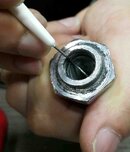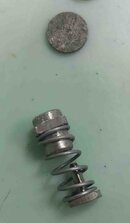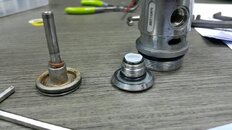HISSDC
Registered
Been fiddling with salt remains for months, but still can't find an effective and safe way to clean these.
I don't have images of the worst case, but as shown in the attached files most has green, white. brown stuff inside and nothing worked so far.
I've tried warm water and dish washer, but it was no use.
I'm too afraid to use vinegar, since I've heard it can damage the chrome coating.
I have access to a ultrasonic cleaner for eye glasses, but not using it since I have no idea what damage the chemicals for a regulator can cause on it, plus I'm not sure if the vibration is strong enough.
Is there a good way to remove these? Are chemicals aimed for salt such at 'salt away' effective? I've also heard about boiling the metal parts. Does that work well?
Also, is the orange- brown corrosion a different matter? Does it require a different way to remove these, or is this corrosion permanent and can't be helped?
And by what passage can a regulator flood? I had no problem using the regulator, detected no leak whatsoever, never left dust cap open when soaking, and then I found white and green salt residue all over the inside. Perhaps a loose hose/port? How do I prevent salt water from entering the 1st stage at all? It's really frustrating me that most of our regulators have signs of sea water inside.
+Every time I open a regulator yoke nut with a wrench, I can't help but scratch off the chrome coating, exposing the brass. Is there a better way of opening it?
I don't have images of the worst case, but as shown in the attached files most has green, white. brown stuff inside and nothing worked so far.
I've tried warm water and dish washer, but it was no use.
I'm too afraid to use vinegar, since I've heard it can damage the chrome coating.
I have access to a ultrasonic cleaner for eye glasses, but not using it since I have no idea what damage the chemicals for a regulator can cause on it, plus I'm not sure if the vibration is strong enough.
Is there a good way to remove these? Are chemicals aimed for salt such at 'salt away' effective? I've also heard about boiling the metal parts. Does that work well?
Also, is the orange- brown corrosion a different matter? Does it require a different way to remove these, or is this corrosion permanent and can't be helped?
And by what passage can a regulator flood? I had no problem using the regulator, detected no leak whatsoever, never left dust cap open when soaking, and then I found white and green salt residue all over the inside. Perhaps a loose hose/port? How do I prevent salt water from entering the 1st stage at all? It's really frustrating me that most of our regulators have signs of sea water inside.
+Every time I open a regulator yoke nut with a wrench, I can't help but scratch off the chrome coating, exposing the brass. Is there a better way of opening it?






